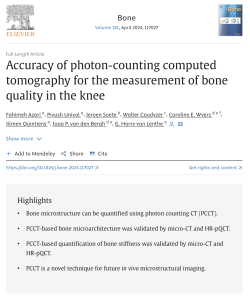 Abstract
Abstract
Visualization and quantification of bone microarchitecture in the human knee allows gaining insight into normal bone structure, and into the structural changes occurring in the onset and progression of bone diseases such as osteoporosis and osteoarthritis. However, current imaging modalities have limitations in capturing the intricacies of bone microarchitecture. Photon counting computed tomography (PCCT) is a promising imaging modality that presents high-resolution three-dimensional visualization of bone with a large field of view. However, the potential of PCCT in assessing trabecular microstructure has not been investigated yet. Therefore, this study aimed to evaluate the accuracy of PCCT in quantifying bone microstructure and bone mechanics in the knee. Five human cadaveric knees were scanned ex vivo using a PCCT scanner (Naetom alpha, Siemens, Germany) with an in-plane resolution of 146.5 μm and slice thickness of 100 μm. To assess accuracy, the specimens were also scanned with a high-resolution peripheral quantitative computed tomography (HR-pQCT; XtremeCT II, Scanco Medical, Switzerland) with a nominal isotropic voxel size of 60.7 μm as well as with micro-computed tomography (micro-CT; TESCAN UniTOM XL, Czech Republic) with a nominal isotropic voxel size of 25 μm which can be considered gold standards for in vivo and ex vivo scanning, respectively. The thickness and porosity of the subchondral bone and the microstructure of the underlying trabecular bone were assessed in the load bearing regions of the proximal tibia and distal femur. The apparent Young’s modulus was determined by micro-finite element (μFE) analysis of subchondral trabecular bone (STB) in the load bearing regions of the proximal tibia using PCCT, HR-pQCT and micro-CT images. The correlation between PCCT measurements and micro-CT and HR-pQCT, respectively, was calculated. The coefficients of determination (R2) between PCCT and micro-CT based parameters, ranged from 0.69 to 0.87. The coefficients of determination between PCCT and HR-pQCT were slightly higher and ranged from 0.71 to 0.91. Apparent Young’s modulus, assessed by μFE analysis of PCCT images, correlated well with that of micro-CT (R2 = 0.80, mean relative difference = 19 %). However, PCCT overestimated the apparent Young’s modulus by 47 %, but the correlation (R2 = 0.84) remained strong when compared to HR-pQCT. The results of this study suggest that PCCT can be used to quantify bone microstructure in the knee.
